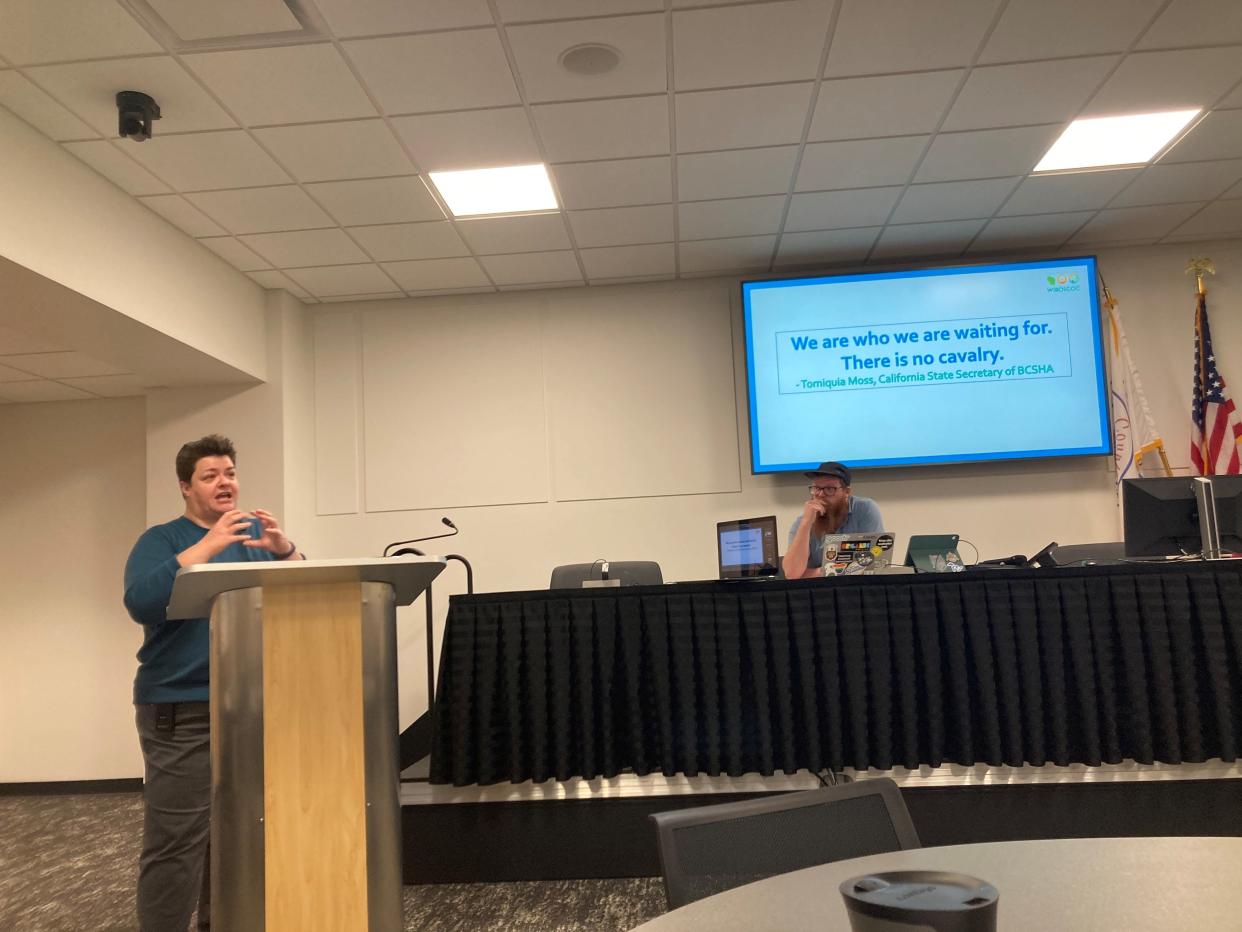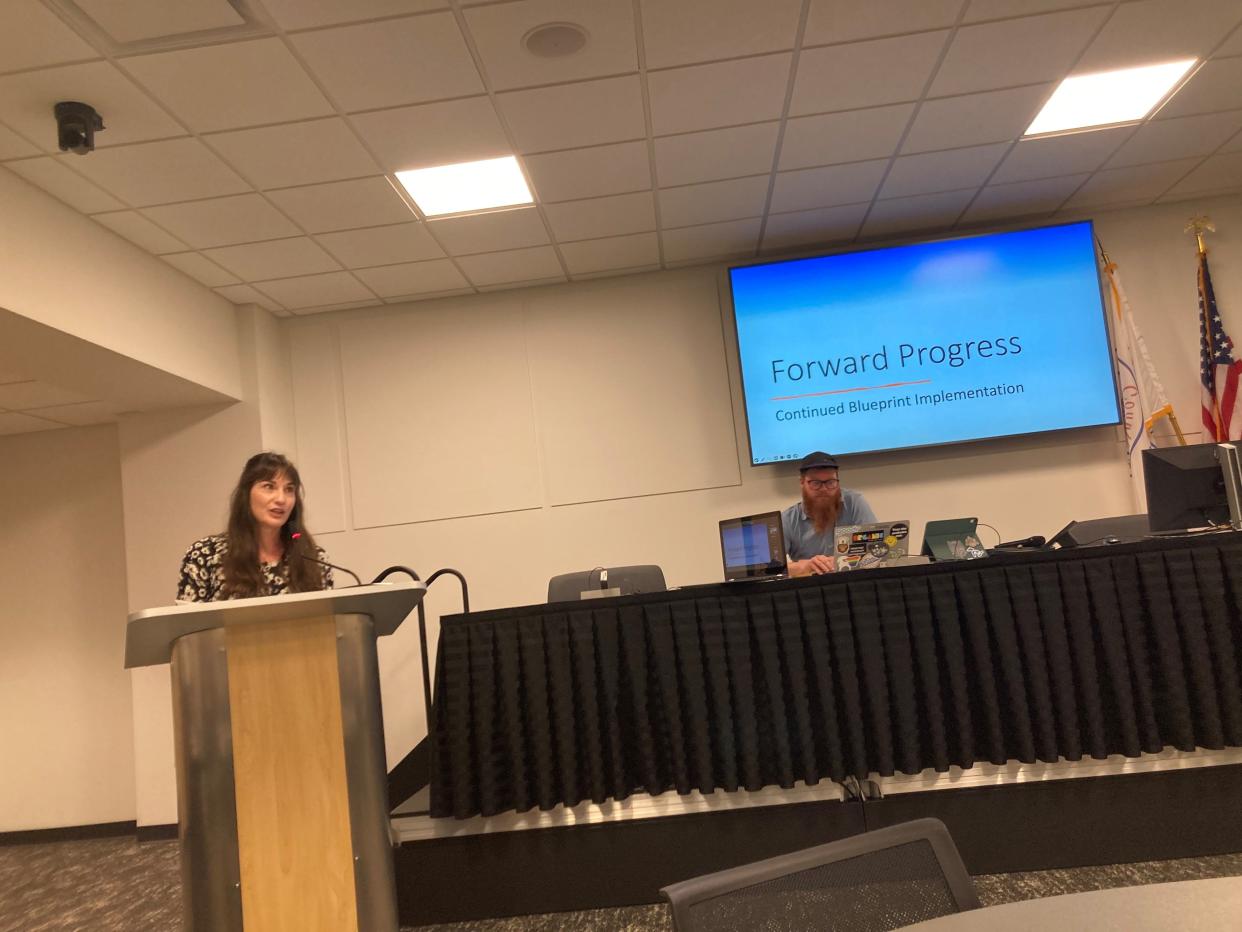Brown County's homelessness numbers 'startling,' says leader of Wisconsin Balance of State
GREEN BAY – Even though Carrie Poser has been analyzing homelessness data since 2015, she was startled when she learned of the 86 unsheltered people living in Brown County this year, nearly doubling the 48 in 2023.
Poser works as the director of the Balance of State Continuum of Care, an association that works with 69 counties, including Brown.
"Eighty-six as a number was startling for me," Poser said Wednesday morning at the Brown County Central Library during the 2024 State of Homelessness in Brown County presentation.
In previous years, the total number of unsheltered people — meaning those sleeping in places not meant for human habitation — rarely veered above 100 across Balance of State’s 69 counties. But when coalition members conducted point-of-time counts in January, which are unduplicated counts on a single night of people experiencing homelessness, they counted 343 humans living unsheltered in those counties — a 28% increase from 2023.
Brown County made up 25% of that count.
Read report on Wisconsin's homeless: Wisconsin's homeless rate edges upward, after nearly a decade of a downward trend
To put this in perspective, Dane County, which has more than double the population of Brown County, counted 90 unsheltered people in January. Milwaukee County, which has more than triple the population of Brown County, counted between 100 and 130 people in January.
“That is the data that I’m sharing through other people, to put it on our state department’s radar,” Poser said. “This isn’t getting better.”

Wednesday’s presentation, which also included an update from blueprint implementation project director Lydia Van Thiel on the Greater Green Bay Blueprint to Prevent and End Homelessness, demonstrated the need for more affordable housing at a time when the homelessness trends are worsening. Presenters also shared the four phases they’re working on, through a series of Blueprint tasks, to get people struggling with homelessness permanent residence.
Here’s what to know about Wednesday’s presentation.
How many people in Brown County are experiencing homelessness?
In Brown County alone, 616 people are experiencing homelessness, whether that means being unsheltered, living in emergency shelters or transitional housing, or people being served through victim service providers.
Between July 1, 2022, and June 30, 2023, for every 10,000 Brown County residents, 77 experienced homelessness. That’s more than twice the state’s rate over the same timeframe: for every 10,000 Wisconsin residents, 35 experience homelessness.
At the same time, households with children are increasingly being referred to the Homeless Management Information System (HMIS), which reached 38% of all referrals in 2024. That’s nearly 10 percentage points higher than last year and the highest it’s been since at least 2020.
People with kids between the ages of 25 and 34 are referred to the HMIS more than people without kids that same age, with 49% of households with kids compared with 19% of households without kids in that age group.
Black households with children are by far the most impacted group referred to the HMIS system, representing 35% of all households with children in need of services. Black residents make up just 3% of Brown County’s population, but are 14 times more likely to experience homelessness than Brown County’s white population.
Even with such a disparity, just 22% of Black people experiencing homelessness are currently entering HMIS programs.
Additionally, more younger and older people are experiencing homelessness in recent years, which is of particular concern for Poser, who said our current systems aren’t designed to accommodate elderly populations.
Contrary to some assumptions about where homeless people are coming from, Poser made it clear that 93% of all people served in shelters, street outreach and transitional housing in 2023 were from Brown County.
How long and how often are Brown County residents experiencing homelessness?
Between Oct. 1, 2022, and Sept. 30, 2023, the average length of time that someone in Brown County is homeless is a little more than 83 days, an 8.5% increase from 2021 to 2022.
The most common length of time that people stayed in Brown County shelters was between 91 and 180 days, which served 313 people.
In observing recurrences, 33% of people who left emergency shelters between 2022 and 2023 experienced homelessness again. During that same, a little more than 12% of people who found permanent housing returned to homelessness.
Nearly 26% of people exiting emergency shelters and rapid rehousing programs found permanent housing. A little more than 98% of people in permanent supportive housing found permanent housing.
The need for affordable housing is also about building more housing of all kinds, Poser says
John Searles, a member of the Greater Green Bay Regional Council to Prevent and End Homelessness, told the Press-Gazette that the state needs to create about 120,000 housing units for working families and seniors to close the housing gap.
The answer isn’t to shuttle people experiencing homelessness out of the city or even into shelters, although the latter is a temporary solution, Poser told the Press-Gazette. Right now, shelters are “busting at the seams” trying to accommodate people, and it’s an expensive endeavor.
“We’ve got to get people housed. We've got to get them into permanent solutions, whatever that might be for them,” Poser said.
Poser explained that it isn’t just a matter of adding affordable housing units. It’s about not having adequate housing for a variety of different sectors of a given community.
An example Poser often gives people to explain this is a familiar one: empty nesters living in a house too big for them might be looking to downsize, but there’s no place for them to go with their retirement plans, so they stay put since the house is paid off. But that means a growing family can’t find a bigger house to move to from their starter home. And that means people who are renting and looking to afford a starter home can’t find upward mobility. Which then means someone in need of affordable rent has nowhere to go.
“So that cycle, in every community, seems to be broken in one of those spots,” Poser said. “People get really frustrated that these big fancy apartments are going up. But it's like, no no, you need those too, because you need people to get out of the typical rental market to make space for our clients.”
In order to solve the homelessness situation for the 447 households currently in the Housing Management Information System, Poser said what's needed are 63 more units of permanent supportive housing, 241 units for rapid rehousing with intensive case management to address substance use and behavioral health challenges, and 133 units for rapid rehousing, which requires a “lighter touch.”

Greater Green Bay Blueprint: Phase Zero
Van Thiel, the project director of the Greater Green Bay Blueprint to Prevent and End Homelessness, said they are currently in phase zero of the blueprint project, but, despite its name, that’s not nothing.
The group has accomplished 30% of the nearly 100 tasks outlined in its roadmap. Some of that includes:
Golden House, Brown County’s domestic violence shelter, expanded its capacity and operations.
House of Hope and Newcap opened 24/7 drop-in centers for youth, and Newcap opened a shelter for young adults ages 17 to 24.
Foundation RAYS Youth Services bought a new transitional living facility for youths transitioning out of foster car.
COMSA created a new child care training program for Somali residents to become certified child care providers.
They got 54 new landlords to accept Housing Choice Vouchers (Section 8).
They hired more street outreach workers, housing navigators and behavioral health staff.
They expanded access to employment programs with Division of Workforce Development’s Worker Connection program
Phase One will begin this year and continue into 2025. Big goals will include:
Minimizing the barriers to new housing developments.
Using more existing housing stock.
Supporting nonprofits owning property and becoming landlords.
Continuing to engage landlords about the importance of accepting vouchers.
Hiring more housing navigators and stability specialists.
“We know that if this work is going to be successful long term, and that we're actually going to end homelessness in Brown County, we need to have our entire community supporting the work and the efforts,” Van Thiel said.
The Balance of State Continuum of Care is made up of 21 local coalitions who share the goal of ending homelessness. Balance of State is one of four associations in Wisconsin that are part of the U.S. Department of Housing and Urban Development’s Continuum of Care programs. The others are in Milwaukee, Dane and Racine counties.
To learn more about advocacy and getting involved, head to the Wisconsin State of Balance website: www.wiboscoc.org.
Natalie Eilbert covers mental health issues for USA TODAY NETWORK-Wisconsin. She welcomes story tips and feedback. You can reach her at neilbert@gannett.com or view her Twitter profile at @natalie_eilbert. If you or someone you know is dealing with suicidal thoughts, call the National Suicide Prevention Lifeline at 988 or text "Hopeline" to the National Crisis Text Line at 741-741.
This article originally appeared on Green Bay Press-Gazette: Homelessness shot up 28% across 69 Wisconsin counties. What can be done?
